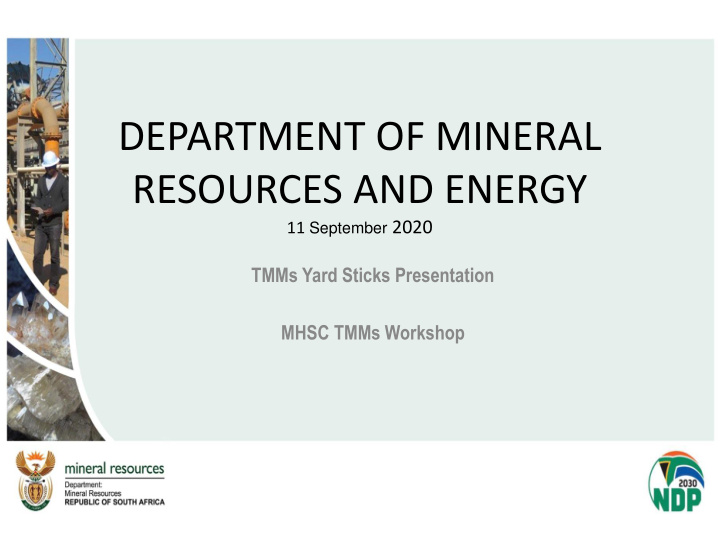



DEPARTMENT OF MINERAL RESOURCES AND ENERGY 11 September 2020 TMMs Yard Sticks Presentation MHSC TMMs Workshop
INTRODUCTION PURPOSE Learnings from the Mining Industry incidents in terms of Trackless Mobile Equipment led to the identifying of the mentioned Yard Sticks to be implemented as Best Practices to ensure safer machinery equipment. OBJECTIVE To reduce mining-related deaths, injuries and ill health through the application of systems that monitor, audit and enforce compliance in the Mining Sector.
PRESENTATION OUTLINE Yardstick Dashboard • Fatigue management • Pre-use checklists of trackless mobile machines • Roll-over protection systems(ROPS) • Falling objects protection systems(FOPS) • Procurement • Checklist of all trackless mobile machines • Pedestrian detection system • Anti-collision device • Brake interlocking on trackless mobile machine doors • Contractor packs
Yardstick Dashboard Continued • Brake test ramps • Fitness to perform work(medical) • Fire suppressions & Fire extinguishers • Emergency preparedness • Illumination • Equipment noise monitoring • Airborne pollutants • Training
FATIGUE MANAGEMENT 1. Electronic monitoring System 2. Short and long distance warning Radars 3. Cameras for blind spot visibility i.e. Haul Trucks 4. Fatigue Management Plans 5. Scheduled Fatigue Breaks 6. Shift rosters
Pre-Use Checklists 1.Pre-Use Checklists for all Mobile Equipment 2.Checklists must meet the need as required 3.Must identify the real hazards 4.Easy enough for all to understand 5.Proper management of Checklists at operational level
Roll-Over Protection Systems (ROPS) 1. Roll Over Protection in all LDVs 2. Roll Over Protection in all Mini - buses 3. Roll Over Protection for Busses (how feasible is it?) 4. Standardisation of ROPS 5. Must understand the function of ROPS 6. It must not significantly alter the COG
Falling Objects Protection Systems (FOPS) 1. We need to understand our risks 2. FOPS should be designed to eliminate the risk 3. FOPS should be practical 4. Should not create new risks
Procurement 1. Procurement Systems should incorporate Safety from the onset 2. Safety should be a non negotiable on all contracts 3. Safety professionals should be involved in all tenders 4. Quality inspections in the manufacturing, repair and compliance to SANS and international safety standards 5. Equipment procurement and selection must be risk based
Checklist of all TMMs 1. Mines should have a detailed list of all TMMs 2. All TMMs must have specific Pre-Use Checklists 3. Checklists should be risk based 4. Checklists should be user friendly 5. Future of electronic Checklists
Pedestrian Detection (PD) System 1. Radars and Cameras act as PD System 2. PD Systems for LDVs (number of operations already have or are busy investigating) 3. Interaction between people and machines remain a high risk on open pit operations
Anti Collision Devices 1. Radars in Haul Trucks 2. Cameras on Haul Trucks 3. System which de-rates power in Haul Trucks when in close proximity to other TMMs – been investigated 4. Systems should not irritate operators 5. Systems should be tamper proof 6. Different systems should talk to each other 7. System overload?
Brake Interlocking (Doors) • Not applicable Underground
Contractor’s Pack 1. Contractor management remains a high risk area for all open pit mines Contractor’s packs must be in place for all contractors 2. No contractor’s pack = no work 3. Contractor’s packs audited on regular basis 4. 5. There should be no difference between contractors and own employees in terms of: – Safety training – Safety Requirements – Procedures
Maintenance System 1. Planned Maintenance for all equipment should be scheduled on a user-friendly system 2. OEM requirements should be understood 3. Qualification of artisans very important 4. Mines should have an Emergency break downs management system al contractor equipment should be in the Mine’s maintenance system
Brake Test Ramp 1. Brake test ramp standard on DMR Website 2. Brake testing with a SIMRET brake tester shall be done after every service, every time when maintenance or repairs on brakes are performed as well as every time when any brake related problems have been reported. 3. Use the supplier’s instruction sheet as a procedure for the dynamic testing of brakes.
Fitness to Perform Work (Medical) 1. Requirement of the MHSA act, due to the nature of tasks associated with operating TMMs. 2. It requires certain medical check points: Diabetes (insulin dependent), hypertension, depth perception, vision testing, color test= due to the amount of color used on instrument panels and warning systems. Hearing fitness (Audiometry).
Fire Extinguishers 1. Ensure adequate risk assessments are in place for the type of fire fighting equipment to be used. 2. Ensure fire fighting equipment is suited to the need 3. Ensure that all operators are adequately trained to use the specific fire fighting equipment 4. Maintenance schedule is important
Fire Suppression systems 1. Automated suppression systems can be installed to minimize reliance on administrative control delivered through training to the operator. 2. Should reduce risk 3. Training is important
Ergonomics Assessment 1. We need to consider the physical aspect of man machine interface. 2. Section 21 of the MHSA requires an ergonomic Assessment to be done. 3. We need to understand the effect of warning devices in the cab on the operator 4. Environmental conditions in the cab, especially in the summer months and cold nights.
Illumination Illumination is not only the head ILLUMINATION SURVEY FOR MOBILE EQUIPMENT lights on a Machine or vehicle, Date of assessment: Time: the main purpose of illumination Activity area/workplace description is to provide contrast, to increase Vehicle Information Vehicle illumination sources Machine number Front Make Back risk identification ability of the operator. Model Spot lights Other Other Front position Recorded illumination at measurement position Visibility should be seen in the whole context especially Distance from vehicle A B C 20m (Dim) where you have light and heavy 20m (Bright) Lux meter information machinery/vehicle interaction. Instrument used Calibration date Serial number Certificate number Front A B C 20m Remarks and Recommendations
CONCLUSION IT IS IMPORTANT THAT ALL THE STAKEHOLDERS SHOULD LIVE THE THEME OF STRIVING FOR ZERO HARM ENSURING EVERY MINE WORKER RETURNS FROM WORK UNHARMED EVERY DAY.
Recommend
More recommend